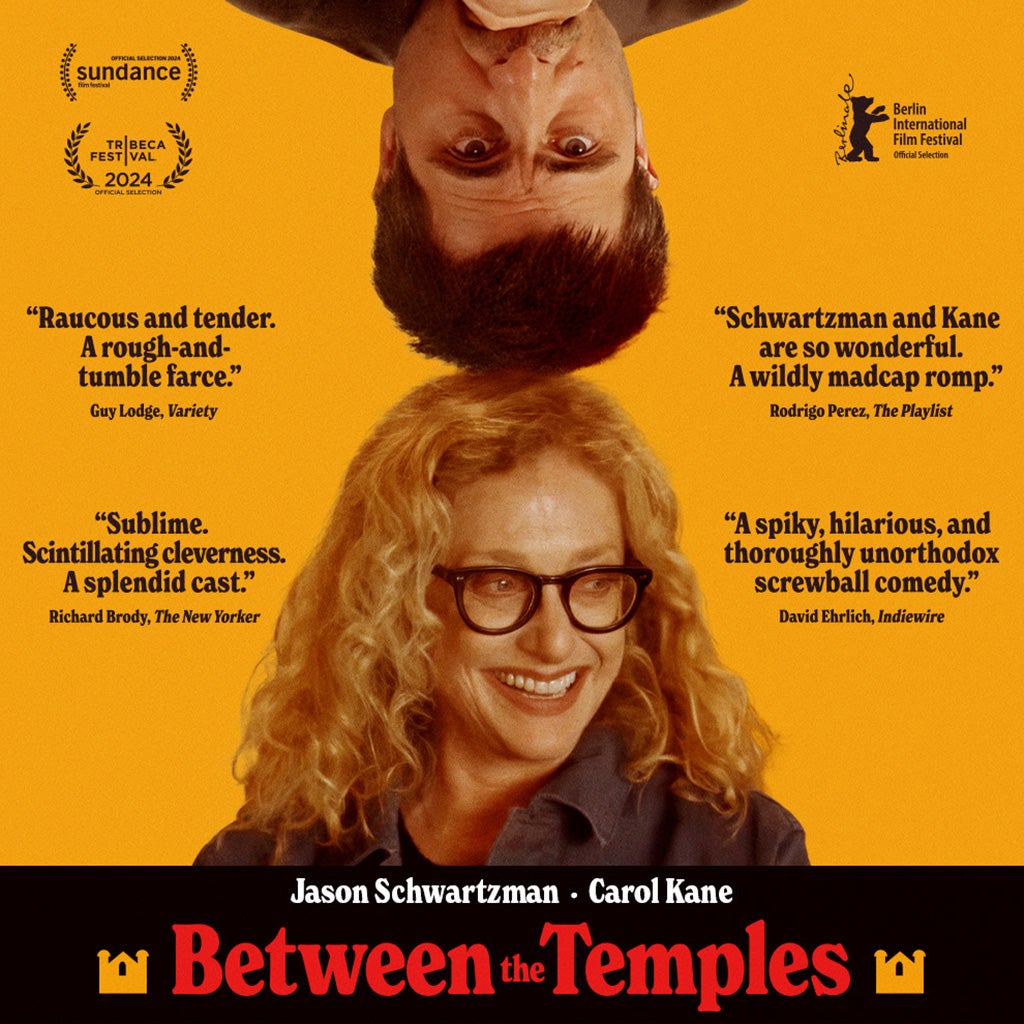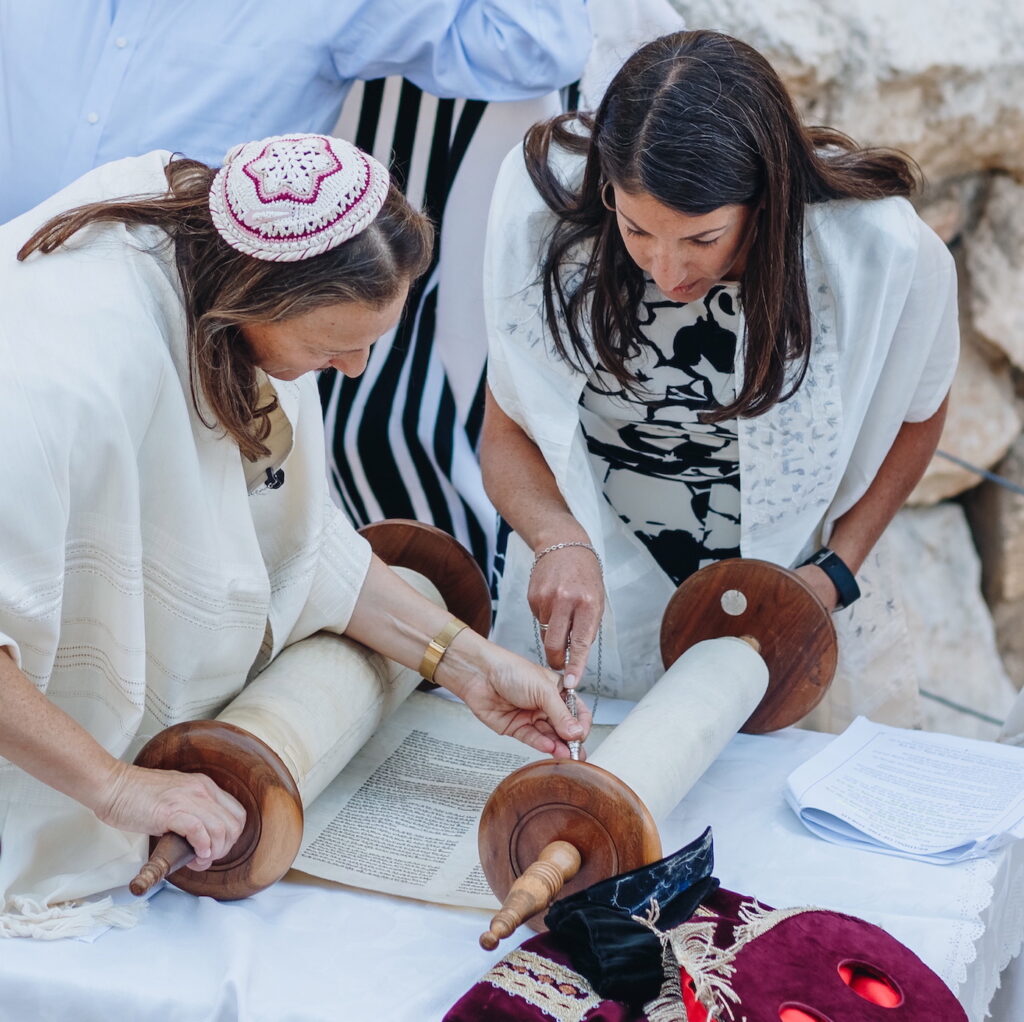A Cantor and an Adult Bat Mitzvah Student Meet in a Bar
A review of the new film “Between the Temples”

(Image source: Raj Dhunna)
When Cantor Ben Gottlieb (Jason Schwartzman) tells Carla Kessler O’Connor (Carol Kane) that she is a “funny lady” in Nathan Silver’s film Between the Temples, she asks, “then how come you don’t laugh at my jokes?” Ben replies, “It’s a different kind of funny.” This repartee between the two protagonists who rescue one another from grief and loneliness aptly characterizes the film itself. Between the Temples IS humorous, but its humor is part poignant, part acerbic. There’s plenty of Jewish funny business here, but Judaism is more than the butt of a joke. In sharp contrast to most other American Jewish movies featuring cantors or Jews coming of age, Between the Temples uses offbeat comedy to embrace Jewish practice.
The film opens with Ben’s moms telling their clearly depressed son that he needs to see a doctor. He assumes they are staging a psychological intervention that he knows he needs and acquiesces. A few minutes later, Dr. Plotnick—Rachel—arrives. Rather than a psychologist, she is an unattached facial surgeon, and Ben and the audience quickly come to understand that this is actually a dating set-up. These moms may be lesbian—a fact that refreshingly merits no commentary—but they have much in common with an earlier cinematic Jewish mother: Mrs. Stein in Kissing Jessica Stein (2001) who views even Yom Kippur services as a solemn occasion for matchmaking. When Rachel feels Ben’s face—she is, after all, a facial surgeon—she asks him if he cries a lot, a clear sign that there’s going to be more here than slapstick comedy courtesy of Jewish mothers.

(Movie poster for Between the Temples)
The source of Ben’s tears is the untimely death of his wife, a hard-drinking writer who died from a brain bleed after falling while drunk. Consumed by grief, he has lost his cantorial voice. Early on in the film, which premiered at Sundance, Ben returns to his synagogue to lead services after a considerable absence. Although he tries to open the Kabbalat Shabbat service with Yedid Nefesh, “My Soul’s Beloved,” he is unable to cough his way through more than the first notes. Fleeing the synagogue, he listens to the last voicemail his wife left him, then lies down in the street, clutches his tallit (prayer shawl), and waits for a truck to run over him. In the next scene, he is waving goodbye to the truck driver, who has dropped him off at a bar. There he will drink too many mudslides, pick a fight with a patron who punches him out, and then be rescued by his old music teacher, Mrs. O’Connor. She reveals herself to have been born Carla Kessler and now has a deep desire to have the bat mitzvah denied to her as a “Red diaper baby” (i.e., the daughter of Communist atheists).
Almost a century ago, a different loss of cantorial voice ushered in the talkie in movies. The Jazz Singer (1927) is the classic Hollywood assimilation story of a cantor’s son who realizes his dream of moving from the temple to the nightclub via blackface and faux jazz. In the 1980 version of that film, Neil Diamond’s belting out of “Coming to America” completes his journey from the synagogue to the stage. But in Between the Temples, assimilation doesn’t stand a chance against the enduring power of Jewish tradition. Rather than desiring to free himself of the cantorial yoke like his cinematic predecessors, Ben mourns his inability to perform ritually. By the end of the film, Ben finally recovers his voice during Carla’s bat mitzvah. Between the Temples powerfully reverses American Jewish cinematic history by combining a coming-of age ritual with a Jewish return to the cantorial fold.
Carla’s bat mitzvah takes place at the edge of the wilderness and is, not surprisingly, profoundly unorthodox. Of course, it’s worth remembering that the coming-of-age ritual for women is a modern phenomenon. Judith Kaplan, the daughter of Rabbi Mordechai Kaplan, was the first girl to have a bat mitzvah. In 1922, at the Society for the Advancement of Judaism, the Reconstructionist Synagogue that Rabbi Kaplan founded, Judith was not allowed to read from the Torah scroll. Women were considered too impure to have direct access to such holiness, and there was a limit on rocking the boat. In her memories of what retrospectively turned into a revolutionary Jewish feminist development, Kaplan says her grandmothers were horrified and wanted to prevent the ritual display of gender equity from happening. Nonetheless, Judith’s Jewish womanhood was liturgically marked. As she recounted:
“l was signaled to step forward to a place below the bimah [platform in a synagogue] at a very respectable distance from the scroll of the Torah, which had already been rolled up and garbed in its mantle. I pronounced the first blessing, and from my own Humash [book containing the first five books of the Hebrew Bible] read the selection which Father had chosen for me, continued with the reading of the English translation, and concluded with the closing brakhah (blessing). That was it [sic] The scroll was returned to the ark with song and procession, and the service was resumed. No thunder sounded, no lightning struck. The institution of bat mitzvah had been born without incident, and the rest of the day was all rejoicing.”
The 1970s saw a rapid expansion of bat mitzvahs, and women who had not had the opportunity to have their Jewish womanhood ritually recognized in their youth began to train for and complete this ritual in adulthood, sometimes in late adulthood. Director Nathan Silver’s own mother, Cindy Silver, started this process in her 60s but did not complete it. But her experience and desire were the germ for this film. Silver reports that his mother, who has a small part in the movie, is the “only critic that counts,” and has “seen the film and gave it a good review.”
Carla recites some of this bat mitzvah history to Cantor Ben (she Googled it); however, in her version, the first coming-of-age ritual for women was conducted at Kaplan’s home rather than the synagogue. Ben repeats this alternative history at the end of the film when Carla chants Torah in the woods behind her home (accompanied only by Ben in fully restored cantorial voice). This historical revisionism honors the role of Judaic innovation that gave birth to the bat mitzvah and the adult bat mitzvah. But it also whitewashes the communal and public nature of the ceremony. The film further reinforces such American Jewish individualism when Ben intones “from here on out, what you do, what you are is up to you and only you.”

(Adult bat mitzvah. Image source: Rabbi Rosalind Glazer)
Just as Cantor Ben’s devotion to his vocation is cinematically unusual, so is Carla’s commitment to this ritual. In such bar mitzvah movies as Keeping Up with the Steins (2006) and A Serious Man (2009), the boys being Jewishly trained to become men are reluctant at best. In part, this stems from spiritually lifeless customs. The Hebrew school scene in A Serious Man reflects the excruciating Jewish educational experiences that too many young Jews endured. And in A Serious Man, bar mitzvah boy Danny chants his Torah portion while high. (Between the Temples recalls that scene when Cantor Ben accidentally drinks hallucinogenic tea and encounters his younger self). The much more earnest film Keeping Up with the Steins takes aim at the attitude that “it doesn’t matter what happens at the temple, it’s the party that counts.” In hopes that life might imitate art, some b’nai mitzvah programs use this film to refocus students on the spiritual dimensions of coming of age Jewishly.
More recently, there has been some much-needed on-screen representation of bat mitzvahs, but those, too, are largely depicted as burdens. In You’re So Not Invited to My Bat Mitzvah (2023), a competition between middle school best friends for the cute, vacuous boy that turns into afterparty drama drowns out most of the meaningful Jewish content in the film (the buzz around this middling bat mitzvah film indicates a hunger for Jewish female representation that merits note). In the miniseries Fleishman is in Trouble (2022), adapted from Taffy Brodesser-Akner’s novel of the same name, a bat mitzvah is aborted. Fleishman, the titular nebbish, is seen as a good father for not compelling his daughter to go through a ritual that has little meaning to her. And In Just Like That (2022), the sequel series to Sex and the City, Charlotte fulfills her dream of becoming an adult bat mitzvah, a revolutionary representation. However, this event only comes to pass because Charlotte takes the place of her nonbinary child Rock, who remains uncommitted to this coming-of-age ritual despite months of preparation.
In sharp contrast, Carla insists on a “shotgun bat mitzvah” after she suffers yet another ministroke (poignantly, Cantor Ben, rather than her son, is the one who sits with her at the hospital). Having this ritual affirmation of her too-long suppressed identity seems like a Jewish feminist declaration of independence. Her son, who professes to be an anti-antisemitic atheist, tries to dissuade her and invokes his dead father’s likely disapproval. But her will—and wit—win Cantor Ben over, and he concocts the prospect of a significant donation to get the rabbi to agree. Part of Cantor Ben’s job is to coach Carla not only in chanting Torah but also in basic Jewish literacy. In one bit between these two misfits who co-educate one another, Cantor Ben spits out a mouthful of hamburger when he learns there is cheese inside. Carla is perplexed and queries “lactose intolerant?” Ben responds, “no, kosher,” and then gives her—and viewers—a mini-lesson on Jewish dietary laws.
Between the Temples is committed not only to Jewish content but also to Jewish casting. In recent years, there’s been much attention paid to non-Jewish actors playing Jews—think Helen Mirren as Golda Meir, Rachel Brosnahan as Mrs. Maisel, Cillian Murphy as Robert Oppenheimer, and Bradley Cooper as Leonard Bernstein to name just a few. Between the Temples explicitly references such ethnoreligious erasures: the rabbi’s daughter, designated as a “mess” and thus a viable catch for Ben, is an actor who keeps “auditioning for Jewish parts that went to shiksa actors” (“shiksa” is a derogatory term for non-Jewish women). However, in sharp contrast to the trend of too many small and big screen productions, the casting in Between the Temples is overwhelmingly Jewish. Jason Schwartzman describes himself as “half Polish-Jewish and half Italian,” and the press notes to the film indicate that making this movie expanded his Jewish knowledge base. Carol Kane as Carla was a particularly brilliant casting choice. Of course, her voice and acting chops lend themselves to the kooky sultriness that defines Carla. However, for Jewish film buffs, Kane will always be associated with her role as greenhorn Gitl who finds her own way to blend old worlds and new in Joan Micklin Silver’s classic Hester Street. Kane, too, says playing this Jewish role influenced her own sense of Jewish being and practice. In interviews, she talks with delight about her Jewish education during the film’s production, including learning to chant Torah and embracing Jewish pride: “It’s important to stand up and be proud of who you are. . . especially right now with the world in such chaos and pain. I don’t think you can crawl into a hole and hide. You have to claim who you are. You can’t control what the response to that will be.”
Perhaps especially post-October 7, Between the Temples is a Jewish cinematic gift. The clever title of the film points to its intermingled psychological and Jewish narrative. Of course, “between the temples” refers to the complexity of what happens in one’s head space, especially when one is dealing with grief and aging. But it also refers to the spiritual drama that occurs between the temple as institutional space, and the temple of one’s heart or soul, a spiritual space unique to individuals. In this film, American Jewish cinematic history becomes a usable tradition to illuminate that drama and to help tell a cross-generational Jewish love story. Between the Temples provides a lens on the sometimes messy, occasionally ridiculous, often poignant process of making Judaism and Jewishness one’s own. It also reminds us that movies themselves can serve as a lifecycle event.
Helene Meyers is Professor Emerita of English at Southwestern University. Her most recent book is Movie-Made Jews: An American Tradition.